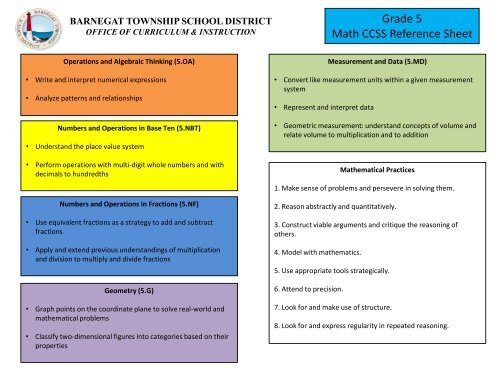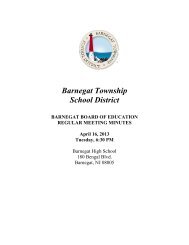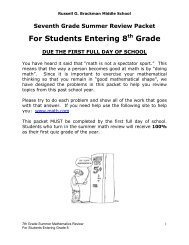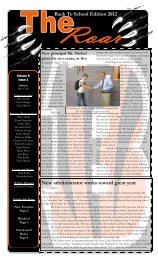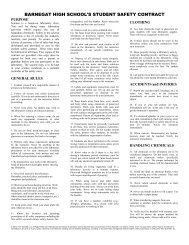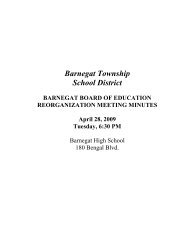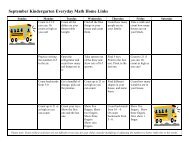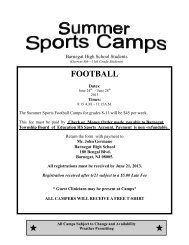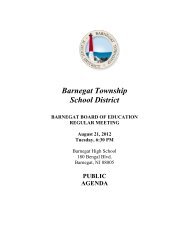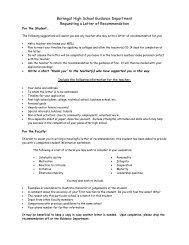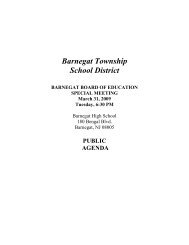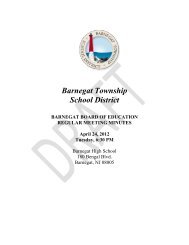Grade 5 Math CCSS Reference Sheet - Barnegat Township School ...
Grade 5 Math CCSS Reference Sheet - Barnegat Township School ...
Grade 5 Math CCSS Reference Sheet - Barnegat Township School ...
Create successful ePaper yourself
Turn your PDF publications into a flip-book with our unique Google optimized e-Paper software.
BARNEGAT TOWNSHIP SCHOOL DISTRICT<br />
OFFICE OF CURRICULUM & INSTRUCTION<br />
<strong>Grade</strong> 5<br />
<strong>Math</strong> <strong>CCSS</strong> <strong>Reference</strong> <strong>Sheet</strong><br />
Operations and Algebraic Thinking (5.OA)<br />
• Write and interpret numerical expressions<br />
• Analyze patterns and relationships<br />
Numbers and Operations in Base Ten (5.NBT)<br />
• Understand the place value system<br />
• Perform operations with multi-digit whole numbers and with<br />
decimals to hundredths<br />
Measurement and Data (5.MD)<br />
• Convert like measurement units within a given measurement<br />
system<br />
• Represent and interpret data<br />
• Geometric measurement: understand concepts of volume and<br />
relate volume to multiplication and to addition<br />
<strong>Math</strong>ematical Practices<br />
1. Make sense of problems and persevere in solving them.<br />
Numbers and Operations in Fractions (5.NF)<br />
• Use equivalent fractions as a strategy to add and subtract<br />
fractions<br />
• Apply and extend previous understandings of multiplication<br />
and division to multiply and divide fractions<br />
Geometry (5.G)<br />
• Graph points on the coordinate plane to solve real-world and<br />
mathematical problems<br />
• Classify two-dimensional figures into categories based on their<br />
properties<br />
2. Reason abstractly and quantitatively.<br />
3. Construct viable arguments and critique the reasoning of<br />
others.<br />
4. Model with mathematics.<br />
5. Use appropriate tools strategically.<br />
6. Attend to precision.<br />
7. Look for and make use of structure.<br />
8. Look for and express regularity in repeated reasoning.
BARNEGAT TOWNSHIP SCHOOL DISTRICT<br />
OFFICE OF CURRICULUM & INSTRUCTION<br />
<strong>Grade</strong> 5<br />
ELA <strong>CCSS</strong> <strong>Reference</strong> <strong>Sheet</strong><br />
Reading for Literature (5.RL)<br />
• Quote exactly from a text when<br />
explaining what the text says and when<br />
drawing inferences from the text<br />
• Compare/contrast two or more<br />
characters/settings using specific details<br />
• Compare/contrast stories in the same<br />
genre on similar themes/topics<br />
• Explain how chapters, scenes or stanzas<br />
fit together to provide structure for a<br />
particular story, drama, or poem<br />
• Read and comprehend stories, dramas<br />
and poetry of appropriate complexity<br />
(independently and proficiently)<br />
Reading for Informational Text (5.RIT)<br />
• Quote exactly from a text when<br />
explaining what the text says and when<br />
drawing inferences from the text<br />
• Determine two or more main<br />
idea/supporting details; summarize text<br />
• Analyze multiple accounts of the same<br />
topic, noting similarities/differences<br />
• Integrate information from several texts<br />
on the same topic to write/speak about<br />
the subject knowledgeably<br />
• Read and comprehend informational<br />
text of appropriate complexity<br />
(science/ss/technical texts)<br />
Reading Foundational Skills (5.RFS)<br />
• Use combined knowledge to read<br />
accurately unfamiliar multisyllabic<br />
words in and out of context<br />
• Read on-level texts with purpose and<br />
understanding<br />
• Read on-level poetry/prose orally with<br />
accuracy, appropriate rate, and<br />
expression on successive readings<br />
• Use context to confirm or self-correct<br />
word recognition and understanding,<br />
rereading as necessary<br />
Writing Skills (5.WS)<br />
• Writing to compose:<br />
1. Opinion piece (State opinion, reason<br />
using linking words and closing)<br />
2. Informative/explanatory texts (Topic,<br />
link ideas and closing statement)<br />
3. Narrative information (Situation with<br />
narrator/characters, dialogue,<br />
sequence of events, closure)<br />
• Explore digital tools to produce and<br />
publish writing<br />
• Draw evidence from literary/<br />
informational texts to support analysis,<br />
reflection, and research<br />
Speaking and Listening Skills (5.SL)<br />
• Engage in conversations about<br />
topics/texts in small/large groups<br />
• Summarize a written text read-aloud or<br />
information/media<br />
• Report on a topic or recount an<br />
experience in an organized manner,<br />
using facts/details to support main<br />
ideas/themes; speak clearly at an<br />
understandable pace<br />
• Include multimedia components/visual<br />
displays to presentations when<br />
appropriate to enhance main<br />
idea/theme<br />
Language (5.L)<br />
• Explain the function of conjunctions,<br />
prepositions and interjections<br />
• Use punctuation, commas, quotation<br />
marks, italics, underlining appropriately<br />
• Consult reference materials, including<br />
dictionaries, to determine meanings and<br />
pronunciation of words/phrases<br />
• Explain the meaning of similes,<br />
metaphors, idioms, adages and proverbs<br />
• Demonstrate understanding of<br />
antonyms/synonyms/homographs


